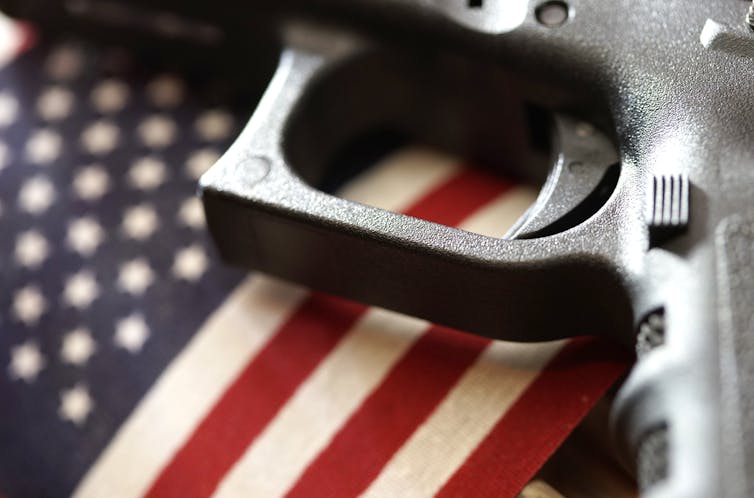
Kameleon007 via Getty Images
April M. Zeoli, University of Michigan and Shannon Frattaroli, Johns Hopkins University
For a large part of the history of the United States, domestic abuse was tolerated under the nation’s legal system. There were few laws criminalizing domestic violence, and enforcement of the existing laws was rare.
It was only in the past few decades that laws criminalizing domestic violence came to be widespread and enforced. But now, the U.S. is in danger of backtracking on that legal framework precisely because of the nation’s historical legacy of turning a blind eye to domestic violence.
On Nov. 10, 2022, a judge in the Western District of Texas struck down the federal law that prohibits access to guns for people subject to domestic violence protection orders. He did this based on a 2022 U.S. Supreme Court ruling, NYSRPA v. Bruen, which held that, to be constitutional, a firearm restriction must be analogous to laws that were in existence when the country was founded. In other words, disarming domestic abusers violates the Second Amendment because those types of laws didn’t exist at the founding of the country.
In a separate, but related, case, the 5th U.S. Circuit of Court of Appeals on Feb 1. sided with the Texas judge, ruling that the federal ban was unconstitutional. The Justice Department has indicated that it will appeal.
We study the link between gun laws and domestic violence in the U.S. and know that backtracking on laws that prevent the perpetrators of domestic violence from getting their hands on guns will put lives at risk – the research has proved this time and time again.
Putting lives in danger
At present, federal law prohibits persons subject to final – rather than temporary – domestic violence protection orders from purchasing or possessing firearms. In addition, 39 states and the District of Columbia have similar prohibitions on their statutes, with many expanding the restrictions to include individuals under temporary, or ex parte, orders prior to a full hearing.
Ruling that these laws are unconstitutional will put mainly women and children in danger. More than 50% of women who are murdered are killed by intimate partners, and most of those homicides are committed with guns. A 2003 study found that when an abusive man has access to a gun, it increases the risk of intimate partner homicide by 400%.
Women constitute the majority of victims of intimate partner homicide, and almost one-third of children under the age of 13 who are murdered with a gun are killed in the context of domestic violence.
Moreover, 68% of mass shooters have a history of domestic violence or killed an intimate partner in the mass shooting.
Enforcement of gun restrictions is spotty, with further research needed as to how systematically they are ordered and whether restricted individuals relinquish firearms they already possess. Nonetheless, research shows that firearm restrictions on domestic violence protection orders save lives. Multiple studies conclude that these laws are associated with an 8%-10% reduction in intimate partner homicide.
Specifically, there are statistically significant reductions in intimate partner homicide when the firearm restriction covers both dating partners and those subjected to temporary orders. This decrease is seen in total intimate partner homicide, not just intimate partner homicide committed with guns, nullifying the argument that abusers will use other weapons to kill.
Moreover, these laws have broad support across the country – more than 80% of respondents to two national polls in 2017 and 2019 said they favor them.
Americans – whether male or female, gun owner or non-gun owner – tend to agree that domestic abusers should not be able to purchase or possess firearms while they are subject to a domestic violence protection order. Most seem to realize that such reasonable restrictions serve the greater good of keeping families and communities safe.
A disregard for data
The ruling in Texas was based on an originalist legal argument rather than the data. Under the judge’s interpretation of the Bruen decision, because colonial law – written before a time when women could vote, let alone be protected in law from violent spouses – didn’t restrict domestic abusers’ gun rights, then it simply isn’t constitutional to do so now. In effect, the ruling, should it stand, would mean the U.S. is unable to escape the nation’s historic legal disregard for domestic violence.
It also disregards the harm that allowing domestic abusers to keep hold of guns does. Multiple studies demonstrate that domestic violence firearm restriction laws are effective and save lives.
That research shows that, should the Texas ruling stand, people who suffer abuse at the hands of an intimate partner are at greater risk of that abuse being deadly.
Lisa Geller, director of state affairs at the Johns Hopkins Center for Gun Violence Solutions at the Johns Hopkins Bloomberg School of Public Health, contributed to this article.
Editor’s note: This story was updated on Feb. 3, 2022 to include the ruling from the 5th Circuit Court of Appeals.![]()
April M. Zeoli, Associate Professor of Public Health, University of Michigan and Shannon Frattaroli, Professor of Health Policy and Management, Johns Hopkins University
This article is republished from The Conversation under a Creative Commons license. Read the original article.
















